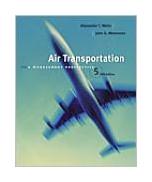|
||
• wydawnictwa polskie
• Zamów informacje o nowościach z wybranego tematu • kontakt
• Cookies na stronie |
AIR TRANSPORTATION A MANAGEMENT PERSPECTIVEWELLS A., WENSVEEN J.wydawnictwo: THOMSON , rok wydania 2004, wydanie Vcena netto: Completely updated to reflect the challenges facing airlines in the 21st century, Wells and Wensveen's AIR TRANSPORTATION: A MANAGEMENT PERSPECTIVE provides comprehensive, sophisticated coverage of both classic and current practices in air transportation management. The authors deftly guide students through the "ins and outs" of the air transportation industry, as well as through the details of management functions within airlines. This edition places greater emphasis on the global airline industry, with such topics as airline passenger marketing, labor relations, financing, and heightened security precautions integrated throughout the text. NEW: Broadened focus on new areas air transportation officials must address--including new operating and safety regulations, policies, and procedures; strategic cost-cutting measures; and more. Chapter 15 ("Airline Financing") now covers late-'90s and early-'00s financial developments, and Chapter 16's coverage of "International Aviation" now emphasizes strategic alliances. End-of-chapter "Suggested Readings" sections are expanded and revised, with references to the latest resources available. Contributions to the fifth edition have been made by Dr. Brent Bowen of the University of Omaha-Nebraska. Current coverage that includes such topics as the growth of air cargo worldwide, the business market and the effects of the General Aviation Revitalization Act, the importance of computers in scheduling, an analysis of the collective bargaining process, and more Coverage of classic principles and practices in air transportation management--in a format that allows instructors to supplement the text with current applications and developments. Coverage of the historical development of air transport and general aviation. Thorough coverage of the government market and civil aviation, with attention to factors affecting commercial transport sales and the contribution of air transport to the economy. Strong visuals, strategically placed within each chapter to emphasize key points. An outline and list of learning objectives for each chapter. Updated instructors' test bank, case studies and PowerPoint presentations are now available. NEW Detailed coverage of 9/11/01and its aftermath in Chapter 2, "Historical Perspective." Expanded sections on recent developments in such areas as aeronautical engineering, airline scheduling, aviation security, and legislative/regulatory policy. Fleet planning coverage (Chapter 13) now focuses on new-generation aircraft--such as the Boeing 777, and the Airbus A380. Updated charts, tables, figures, statistics, and photos throughout--as well as updated key terms, review questions, end-of-chapter "Suggested Readings" and Web links at the end of each chapter. All-new end-of-chapter sections list URLs from various aviation Web sites to take students beyond the pages of the text to the latest information on the Internet. Traffic and financial highlights in Chapter 5 are updated with 21st-century figures/statistics. The Airline Development section in Chapter 7 has been updated; Chapter 9 on "Airline Passenger Marketing" has been updated to reflect recent trends, and the authors have expanded their coverage of "Principles of Airline Scheduling" in Chapter 12. Chapter 14 includes discussion of most recent labor-management disputes. 622 pages Księgarnia nie działa. Nie odpowiadamy na pytania i nie realizujemy zamówien. Do odwolania !. |


